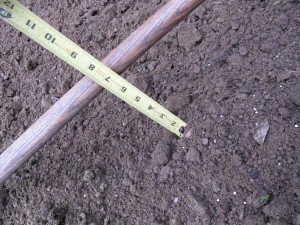Planting Shrubs
Irish writer Thomas Moore (1779-1852) once wrote, “A piece of the sky and a chunk of the earth is lodged in the heart of every human being.” I would like to add “And hopes for a seed waiting to be planted”. It’s why we garden – or I do, anyway – planting, watering, tending and harvesting make me feel alive, keep my temperament balanced and give me joy.
It’s mid-October and there aren’t any seeds to be planted just now (unless you count garlic cloves as seeds). But this is a good time to plant trees and shrubs. Plants store energy from photosynthesis all summer in their roots, and then in the fall the roots use that energy to extend their range – even after leaf drop. Roots grow, apparently, until the ground freezes. Roots start growing again in the spring, and do much of their root growth in early summer.
For me, the hardest part of planting a tree or shrub is finding the proper place to plant it. I have a couple of acres, but I’ve been planting things here for over 40 years and I’m running out of space. Not only that, each tree or shrub has specific needs for sunlight exposure, moisture and soil type.
Soil is the easiest to “customize”. I can change the pH and texture or tilth pretty easily. But my back field is pretty wet, and many woody plants don’t like their roots sitting in soggy soil. With a high water table, I have to limit what I plant there. (Willows love it, and my magnolia , too.)
Sunlight is also hard to adjust. Yes, I have a chain saw, but nice trees keep on getting nicer as they grow – but creating more shade. Many nice flowering plants like full sun, which is defined as 6 hours or more of summer sun per day.
After removing a pear tree earlier this year, I had space to plant a blue hydrangea (A ‘Twist and Shout’ variety of the Endless Summer series) that had been growing in a big pot near my front door all summer. I cleared out the weeds and loosened the soil in a 5-foot circle. Then I modified the soil to meet the needs of this particular shrub: I added peat moss and garden sulfur to acidify the soil, stirring it in with my CobraHead weeder.
It’s important to get the depth of the planting hole right for trees and shrubs, much more so than for vegetables or flowers. Trees (and to a lesser degree, shrubs) can be damaged if planted too deeply, as the bark on the trunk is very susceptible to fungal rot if covered with soil or mulch. Vegetables such as tomatoes and broccoli can be planted a little deep in order to stimulate new root growth along the buried stem.
It is good to dig the hole for a tree or shrub just the depth of the root ball. After I removed my hydrangea from the pot I measured the root ball and found it to be 8 inches from surface to bottom. I dug a hole and measured the depth of it by placing the handle of a rake across the hole, and then checking it with a measuring tape. It was 6 inches at first, so I carefully scraped out 2 more inches. That allowed me to set the root ball on unexcavated soil; soil that has been dug out and replaced tends to settle – which you don’t want to happen. Sometimes, if the soil is really awful, I will dig down deeper, and then add improved soil and pack it down afterwards with my foot.
The shape of a planting hole for a tree or shrub is important. It should be flat on the bottom, and gently slope upwards toward the surface of the soil. It should be wide, not deep. A minimum width should be three times the size of your rootball, and five times is even better. Roots of most trees and shrubs go wide, not deep. Roots go out beyond the ”drip line” – the area directly under their leaves. So it is good to have nice loose soil around your tree or shrub to facilitate root growth.
Winter is not so far away. In order to allow roots to grow and develop for as long as possible, it is good to place a two-inch layer of mulch over the root zone – but no more than 2 inches. The mulch will keep the soil warm later into the fall and keep lawn mowers and those string trimmers at bay.
I’ve seen trees with what I call “mulch volcanoes” – mulch piled up deeply against the trunk of a tree. That can be a death sentence, as most bark mulch or ground branches will retain moisture and microbes that will eventually rot the cambium layer of a tree. It takes years to kill a tree with bark mulch, so many people don’t attribute the layer of mulch to the death of their tree six to ten years later. Leave a “donut hole” free of mulch around your tree to avoid that.
So go to your local garden center and buy yourself a nice tree or shrub. There is still plenty of time to plant. And I think you’ll feel a great sense of accomplishment if you do.
Henry Homeyer is a gardening teacher, coach and public speaker. Reach him at henry.homeyer@comcast.net or P.O. Box 364, Cornish Flat, NH 03746. He is happy to answer gardening questions, but please include a stamped envelope if sending a real letter.




